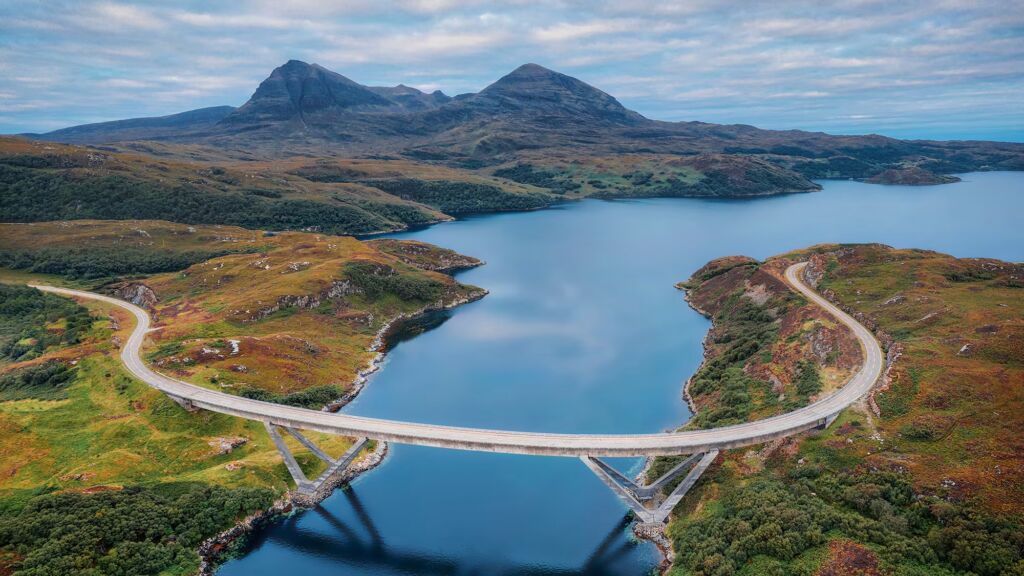NC500 is a circular route on public roads across the Northern Highlands. Starting and finishing in Inverness, it traces the wild west coast, the far north, and the gentler east. The canonical distance is around 516 miles/830 km; most travelers take 5–10 days. You can drive, ride a motorcycle, or cycle; public transport covers fragments but not the full loop efficiently. Left-hand traffic and narrow single-track roads with passing places dictate conservative speeds and attentive driving.
Origins and purpose
Launched in 2015 to boost the North Highland economy, the route quickly became a modern classic. It has brought new revenue and jobs in hospitality and services, while also sparking conversations about litter, congestion, and seasonality. The current focus is on responsible travel—spreading visits through the year and along lesser-known spurs.
The route and highlights
Clockwise or anticlockwise both work; choose based on light and logistics. The west coast A832/A896 features the famed Bealach na Bà to Applecross (summit about 626 m, gradients up to 20%, tight hairpins—unsuitable for many large motorhomes; detour via Kinlochewe/Shieldaig). Then come Torridon, Gairloch, Poolewe, and Ullapool. The northwest is all rock and sand: Enard Bay, Lochinver, Achmelvich, and the photogenic Kylesku Bridge. At the top: Durness, the accessible Smoo Cave, Sandwood Bay (an 8–10 km out-and-back hike), and remote Cape Wrath (small ferry plus minibus; MOD range). On the northeast, visit Dunnet Head (the mainland’s northernmost point), John o’Groats, dramatic sea stacks, and arches. The east hosts Dunrobin Castle, Wick’s harbours, and distilleries, before returning to Inverness via the Cromarty Firth and Black Isle.
Seasons, weather, daylight
Late spring to early summer delivers long days (June twilight past 10:30 pm), blooms, and fewer midges when breezy. July–August are lush and busy, with midges in calm conditions—bring repellent and head nets. Autumn brings heather and birch colours and quieter roads. Winter offers storms, ice on passes, and short daylight; many services reduce hours. Weather is mercurial year-round—dress in layers and carry waterproofs.
Transport and logistics
Single-track etiquette matters: never park in passing places, use them to let others by, and acknowledge with a wave. Fuel and groceries are available but sparse in the far northwest—plan ahead. Coverage can be patchy; download offline maps. EVs are increasingly viable, with fast chargers in Inverness and key towns like Ullapool and Wick—still, map your stops. Motorhomes should book sites early and avoid narrow dead-ends; many large rigs should bypass Bealach na Bà. Cyclists and motorcyclists need hi-vis, wet-weather gear, and caution in gusty winds.
Stays and food
Choose from B&Bs, inns, hotels, hostels, and official campsites. Wild camping on foot is possible under the Scottish Outdoor Access Code—small groups, short stays, no trace, far from homes and farmland. Sleeping in vehicles outside sites requires landowner permission. Food spans pub staples, fresh west-coast seafood (don’t miss langoustines), full Scottish breakfasts, and farm cafés; in peak season, dinner reservations help.
Things to do
Iconic sights include Bealach na Bà, Kylesku Bridge, Smoo Cave, Balnakeil and Sandwood beaches, Dunnet Head, and Dunrobin Castle with raptor shows. Hikes: Ben Hope (northernmost Munro), Suilven, Stac Pollaidh. Paddling and surf in Thurso and Durness. Wildlife: puffins, guillemots, seals, occasional orcas offshore. Culture: tiny local museums, Pictish stones, crannogs, as well as whisky and gin distilleries.
Safety and sustainability
Aim for 75–100 miles per day with stops—rushing spoils the experience. Carry a first-aid kit, water, and warm layers year-round. Respect gates and livestock; keep dogs leashed. Pack out all rubbish and use campsite disposal points. Travel in shoulder seasons and explore lesser-known spurs to spread benefits and reduce crowding.
Sample itineraries
Five days: Inverness — Torridon/Applecross — Ullapool — Lochinver/Assynt — Durness — Wick/Dunnet — Dornoch — Inverness. Seven to ten days: add hikes (Suilven, Sandwood), a beach day in Sutherland, an Orkney side-trip (ferry from Scrabster), foodie stops in Poolewe and Ullapool, and an east-coast distillery trail.
Budget and bookings
High season raises prices—book accommodation and cars months ahead. Balance campsites with B&Bs to manage costs. Fuel is a major line item; plan refuelling. Many highlights are free (beaches, trails); paid items include museums, castles, boat trips, and ferries. With planning, NC500 fits varied budgets.
Takeaway
The NC500 rewards unhurried curiosity: detour to a quiet cove, sit out a squall in a cosy inn, and hit the trail when the clouds part. That’s when the north shows its calm, rugged grandeur.
- Kahovka
- Brest (Belarus)
- Birds
- Treasure in the Cape Cod fog: A Thai traveler’s encounter with pirate history
- Hiroshima’s nuclear blast: how tragedy reshaped travel routes
- Moab
- Win a four-night Greek getaway for two in one of the most stylish resorts in the Aegean courtesy of Sani Resort
- Minsk (Belarus)
- The Most Dangerous Tourist Destinations for Women: Where to Travel with Extreme Caution
- Chukchi
- Tourist places where Hemingway went
- Irkutsk
- Gibraltar
- The World’s Most Dangerous Countries for Tourism in 2025
- Tourist safety in Bukhara: how to spot and avoid crime
- The Louvre welcomes Renaissance masterpieces from Naples Capodimonte Museum
- Shakira — Waka Waka (This Time for Africa)
- The Crocodile Chase: An Unlikely Friendship Born in Africa
- Nicaragua
- Borneo











